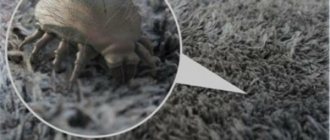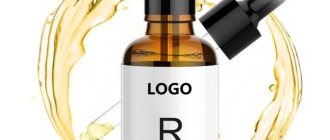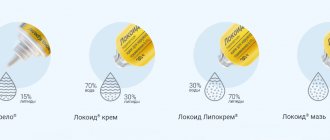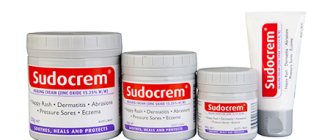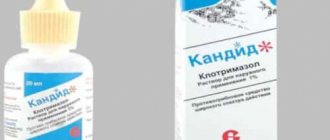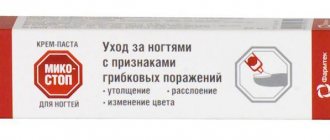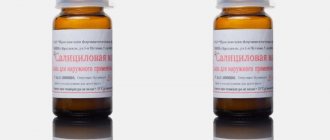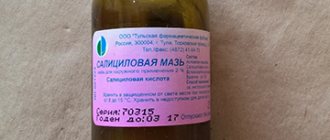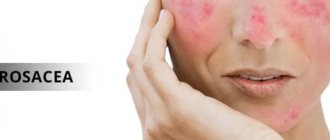In this article we will figure out which is better - Clotrimazole ointment or cream.
Very often, representatives of the fair sex are forced to deal with various fungal pathologies of the genitourinary system. At the same time, some begin to drink expensive drugs, while others plunge headlong into traditional medicine.
Fungal infections are widespread; every fourth inhabitant of our planet suffers from one or another type of fungus, so everyone is interested in effective means of combating such pathologies. The group of effective drugs includes Clotrimazole, which has several release forms.
Ointment is an external type of a popular synthetic imidazole product that is designed to fight fungi.
Many people are wondering what is better - ointment, cream, or Clotrimazole gel.
Properties and composition
The active component of the drug destroys the cell plate of fungal spores. Clotrimazole extracts potassium, phosphorus compounds and biological polymer molecules from the fungal cell. The drug increases the intracellular level of hydrogen peroxide, as a result of which pathogenic microorganisms die. In addition to destroying pathogenic cells, this agent suppresses the process of their further reproduction.
The drug contains the active component clotrimazole. Additional substances: monoglycerides E471, emulsion wax, oil solvent, food additive E1520, stearyl and cetearyl alcohol, glycerin, castor oil, preservatives E218 and E216, distilled water.
Causes that contribute to the appearance of spots on the skin
Exposure of the skin to solar radiation does not always have a beneficial effect on it. Many women like to bask on the sand near the sea all summer or visit a solarium, and this provokes the accumulation of excess melanin in the lower layers of the skin. Later it appears on the face in the form of brownish spots. In old age, such phenomena can be dangerous and lead to skin diseases. Here is another list of reasons associated with increased pigmentation:
- Reaction to diseases of internal organs. Problems with the kidneys, liver, female organs, gall bladder, and intestines contribute to the release of toxins. They promote the appearance of melanin on the skin.
- Exposure associated with the use of chemicals and toxic substances. Most often it appears in people working in chemical production.
- Lack of vitamins C, E, PP. Winter and spring are periods when you need to maximally support the body with vitamins of different groups, and especially those mentioned. Fruits and vegetables should be present in the diet constantly.
- The period of bearing a child (pregnancy). Most often, after childbirth, pigmentation disappears, and sometimes remains. This phenomenon is caused by hormonal changes in women.
- The use of cosmetics and perfumes that contain allergenic dyes, fragrances, esters and extracts. All expensive cosmetics have a complex composition, which is not always accompanied by high quality.
- Age-related changes with the onset of menopause. During this period, pigment spots can cover not only the face, but also the hands.
- Regular injections, peelings, procedures aimed at skin rejuvenation. Such events are not always suitable for women, so they can cause pigmentation.
What is it used for in adults: instructions for use
The drug is actively used to combat fungal diseases and various skin rashes. Depending on the diagnosis and severity, Clotrimazole is prescribed in one form or another.
Antifungal agent
Before using the drug, thoroughly rinse and dry the affected area. Then apply a thin layer of ointment and rub in with massage movements. Using a solution instead of an ointment, 2-3 drops of the product will be enough for an area equal to the size of the palm.
After using Clotrimazole, you must wash your hands with soap (if the ointment was not specifically applied to your hands) to avoid further spread of the fungus throughout the body. Also, after each water procedure, you should wipe dry the areas damaged by the fungus.
For thrush, it is recommended to use tablets or drops in the vagina once a day and apply ointment to the perineum twice a day. For prevention purposes, it is recommended that the woman’s sexual partner also undergo treatment.
During the treatment of fungus, a specially designed towel must be used for damaged areas of the body.
Cream for external use on the face
Before starting therapy, it is necessary to establish the root cause of the rash. Clotrimazole in the form of a cream is used to treat:
- acne;
- age spots;
- mycosis;
- dermatitis.
Facial acne is often caused by staphylococcus or streptococcus bacteria. Clotrimazole, in turn, effectively reduces the level of activity of pathogenic microflora. The first positive results will become noticeable after 3 days.
Clotrimazole is also prescribed to combat age spots. Using the product for 3-4 weeks, dark spots on the skin will become noticeably lighter, and in combination with the right care cosmetics, an improvement in the condition of the facial skin will not take long.
The cause of rashes on the face may be mycosis. The disease manifests itself as a result of the activity of parasitic fungi. Treatment of this disease involves the use of Clotrimazole, but for greater effectiveness it must be used in combination with antibiotics and other antifungal drugs. The cream is also prescribed for dermatitis of various origins.
Side effects
Clotrimazole is usually well tolerated, but in some cases the following side effects may occur:
- Redness of the skin or mucous membrane in the area of application of the product;
- Itching;
- Hives;
- Contact allergic dermatitis;
- A tingling or burning sensation at the site of application;
- Dizziness;
- Nausea.
If a child develops these symptoms, the use of the drug should be stopped and a doctor should be consulted again.
Is it possible for children
Clotrimazole can be used for children strictly with the permission of a doctor. In some cases, in addition to this drug, other antifungal medications are prescribed.
Up to a year
Thrush often occurs on the skin and in the mouth of infants. Clotrimazole ointment and solution are used to treat it. For candidiasis of the skin with increased dryness, ointment is most often used, applying it 2-3 times a day, in a thin layer on a pre-washed (with fragrance-free soap) and dried area. The duration of treatment is at least 2 weeks.
For thrush in the mouth, it is recommended to apply a 1% solution twice a day. For one procedure, a few drops of the drug are enough to treat damaged areas. If positive changes are noticeable after 5-7 days, treatment should be extended to 2 weeks. Otherwise, exclude Clotrimazole.
After a year
Children are often diagnosed with a skin disease such as ringworm, which is transmitted through contact with animals or people with this disease.
Ringworm is characterized by the appearance of red spots on the skin that are itchy and flaky. If microsporia occurs on a non-hairy part of the body, Clotrimazole ointment is prescribed. It should be used up to three times a day, on previously washed areas of the skin. Treatment can last 28-40 days.
In case of lichen in areas covered with hair, Clotrimazole is used in the form of a solution in combination with antifungal drugs for oral administration. For foot sweating accompanied by erosive formations, treatment includes the use of Clotrimazole and powder.
Similarities, differences, cheaper prices
The similarity of these drugs is that they bring the same effect after use.
Clotrimazole ointment absorbs for a long time, penetrates deeply, and forms a film on the surface of the skin, which helps to avoid the appearance of crusts, since it contains a fatty base - Vaseline. The ointment also moisturizes dry areas of the skin surface, is used for dry skin, and eliminates flaking. The ointment is recommended to be applied to exposed skin at night; it should not be applied during pregnancy or breastfeeding.
The cream is based on oil and water. Due to this, it is quickly absorbed, but does not have a long-term effect, does not leave stains on clothes, has a softening effect, and is used for weeping and oily skin. Application of the cream to exposed skin is recommended during the day; use during pregnancy or lactation is possible as prescribed by a doctor, under his strict supervision.
In terms of cost, we can say the following: the ointment costs a little less - about 100 rubles, the cream - from 200.
Price and analogues
The pricing policy of the drug also varies depending on the manufacturer and form of release.
The average price for a pack of tablets is 30 rubles. Products for external use are sold in pharmacies at prices ranging from 50 to 220 rubles. The most expensive is the cream. The price of the solution is approximately 230 rubles.
Analogues of Clotrimazole:
- Kanizon cream for external use with an identical active substance.
- Mycozon. The composition includes the substance miconazole with a dosage of 2%. Used to treat ringworm.
- Kanesten. The active ingredient is identical. Prescribed for the treatment of lichen and other fungal diseases.
- Candide. The cream is used to combat thrush, nail fungus and dermatophytosis.
- Bifosin. Used in the treatment of candidiasis, microsporia, mycosis of the feet and hands.
Patient reviews
Alisa, 30 years old, Rostov-on-Don. Once I had nail fungus. The doctor prescribed treatment with Clotrimazole ointment. Helped in a short time. I didn’t know that it was necessary to continue treatment with it to avoid relapse. A good and affordable remedy for fungus. And recently, a relative developed a fungus on his feet due to active sweating under heavy loads. The ointment became a real salvation. I recommend!
Valery, 48 years old, Ulyanovsk. There was an unpleasant odor of the feet, sweating profusely. I went to a dermatologist and found a fungus. They prescribed Clotrimazole cream. The effect of use came almost instantly. In addition, cracked heels and corns disappeared. Using cream is more convenient for me than ointment, since there are no greasy marks on socks and shoes, and it is quickly absorbed.
Other whitening creams
A cream with a whitening effect can be purchased both in a store and at a pharmacy. Some ointments have been developed for pigmentation, which can only be used as directed by a doctor. These products include Achromin MAX, Retin-A, VC-IP. They carefully remove stains and protect the skin from the effects of ultraviolet rays. These pharmaceutical creams reduce the amount of melanin in the skin and nourish it with vitamins.
Ascorutin cream has excellent whitening properties. It prevents the reappearance of pigmentation. Vichy cream helps eliminate age spots and freckles. You can also lighten dark spots using cosmetic clay by adding a few drops of lemon juice to it.
“Bodyaga” containing silica also removes pigmentation well. One of the ingredients in whitening masks can be salicylic ointment. For the purpose of gradual whitening, zinc ointment is suitable.
The effectiveness of Clotrimazole
Our contemporaries very often use Clotrimazole against age spots. Reviews almost always talk about its effectiveness. What can you achieve by using this drug? The active substances contained in Clotrimazole actively act on darkened areas of the body. This cream acts on the skin and dynamically whitens areas where melanin is intensively produced.
In addition to whitening, the drug also fights fungi and bacteria, so it is recommended for people with problem skin. Clotrimazole will effectively relieve inflammation in the epidermis.
"Clotrimazole" in the fight against age spots
How effective is Clotrimazole for age spots? Reviews indicate fairly high effectiveness. This medication is not only intended to counteract pigmentation, it is designed as an antifungal agent. Often used to treat thrush, as well as fungal diseases of the skin and nails. But recently it has become known how Clotrimazole is used for age spots. Reviews from some women indicate positive results. Its use was also provoked by the fact that this remedy has almost no contraindications and does not cause complications.
Indications for use against fungus on the feet
According to the nosological classification, Clotrimazole is used to treat the following skin diseases of the feet:
- Dermatophytosis (dermatomycosis). This is a group of skin infectious pathologies caused by fungi of certain genera: Trichophyton
,
Microsporum
and
Epidermophyton
. Most often, the anomaly is localized on the big toes and little toes. - Candidomycosis. One of the types of fungal infection. Affects nails and skin of the feet. Etiology – microscopic opportunistic yeast-like fungi of the genus Candida
. - Interdigital mycotic erosion. The fungus damages the upper layer of the epithelium down to the basement membrane. After treatment, the wound surface heals without leaving any traces.
- Mycotic paronychia. An inflammatory process in or under the nail cuticle, caused by various fungi.
- Mold. It is a type of fungal infection. The pathogens are aggressive and difficult to treat.
All of these diseases are caused by various pathogens. Clotrimazole is a broad-spectrum antifungal drug, so it is very effective in getting rid of toenail fungus.
